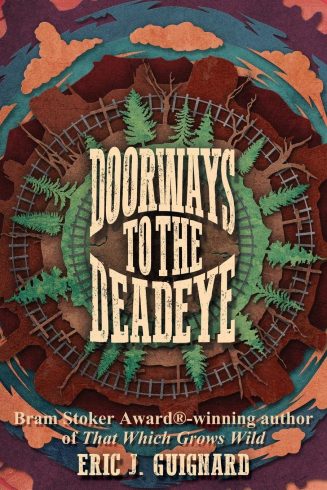 By ERIC J. GUIGNARD (Journalstone; 2019)
By ERIC J. GUIGNARD (Journalstone; 2019)
This is the first novel by Eric J. Guignard, of 2018’s excellent short story collection THAT WHICH GROWS WILD. Short story writers making the jump to long form narrative writing have an unfortunate tendency to botch the job, but that, thankfully, wasn’t the case here. DOORWAYS TO THE DEADEYE is a streamlined and assured concoction, boasting a unique multi-pronged narrative structure that holds the reader’s attention from start to finish.
Storytelling is the theme of this book, which consists of a highly involved story-within-a-story-within-another-story, threaded with mini-biographies of characters whose particulars may or may not be “true”—although, as is made clear on several occasions, in this novel the delineations between truth and falsity aren’t at all clear-cut. Furthermore, the seemingly standalone mini-bios turn out to serve narrative purposes that aren’t initially apparent, filling us in on plot points that the wraparound story, with its unwavering point of view, can’t.
The wraparound in question is related in Los Angeles, 1985. The teller is King Shaw, a dying hobo interviewed by journalist Daniel Greenberg, who, in an example of the irrepressibly time-tripping nature of the book overall, occasionally flash-forwards to 2019; as is claimed at one point, “You arrange the events of a story in a way that’s meaningful, not based on just some timeline.” But anyway: the story Shaw tells Greenburg concerns one Luke Thacker, a hobo living in late 1930s America.
What follows is an extremely well researched depiction of the hobo milieu. Included are quirky details like the so-called Hobo Code signs, written in symbols comprehensible only to hobos. It’s such signs, drafted by an enigmatic figure known as the Code Maker, that alert Thacker to the existence of an alternate reality in which reside several famous American figures—John Dillinger, Harriet Tubman, Lizzy Borden, Benjamin Franklin, Pocahontas, Wyatt Earp—whose natures don’t exactly correspond with those assigned by the history books.
The darker and more hypocritical aspects of America’s history (read: slavery) are fully faced up to in these pages. Also contained is an American-ized take on the myth of Orpheus involving a search for a lost love through a most unexpected underworld, some breakneck action and even some Cronenbergian grotesquerie. We also learn of the connection between King Shaw, whose tales make up the bulk of the text, and Luke Thacker, the subject of those tales, and why it is that Shaw is so interested in Luke’s exploits.
All of this may sound disjointed, and indeed that’s how it feels at first, but the book has a carefully structured narrative ebb and flow that gradually becomes apparent. Hopefully I haven’t given too much of its surprises away, as surprise is something DOORWAYS TO THE DEADEYE has in abundance, and something which deserves to be experienced anew by prospective readers.
